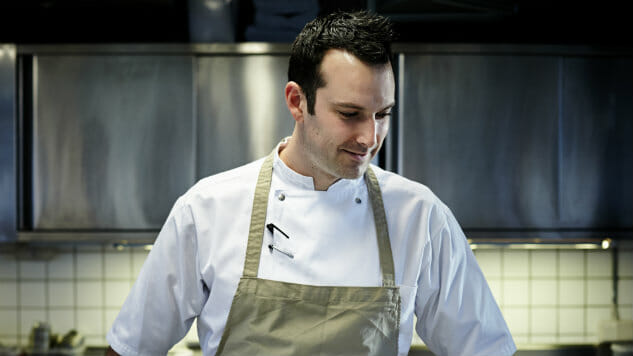
In stark contrast to the image of rock star chefs doing lines in the walk-in, New Nordic chefs are like modern day folk heroes. In the past year, New Nordic has evolved dynamically, specifically in the Danish capital of Copenhagen, the birthplace of Noma, the epicenter of the movement.
In 2016, Michelin’s Nordic Guide put Geranium at the top of Denmark’s list of dining destinations by naming it the country’s first three star restaurant and awarded 16 restaurants in Copenhagen a total of 20 stars – the highest number yet of any city in the Nordic region.
Outside Influences

In the time since the New Nordic Kitchen Manifesto was signed by its 12 founding chefs in 2004, a surge of young talent from all over the world has brought new energy into the kitchens of Copenhagen. And many who have sharpened their skills at Noma have gone on to start restaurants of their own. Like its former pastry chef Rosio Sanchez, a 31-year-old Chicago native who opened the popular taqueria Hija de Sanchez at Torvehallerne food market last year. This year the business is expanding to Copenhagen’s Meat District in Vesterbro, where all your hipster dreams come true.
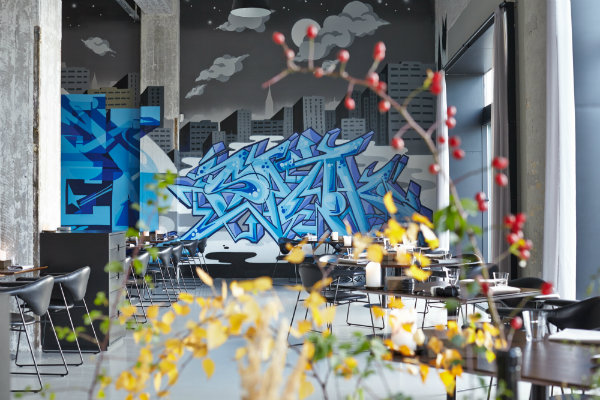
Noma’s former first Chef de Cuisine, 39-year-old American expat Matt Orlando, is now chef-owner of the popular graffiti-walled restaurant AMASS (pictured above), which has been ranked as one of the world’s best restaurants and is known for its initiatives to fight food waste. He agrees that outside influences are making Copenhagen an exciting place to cook right now. It’s also a place where the manifesto’s aim to increase ethically sound environmental practices continues to be explored.
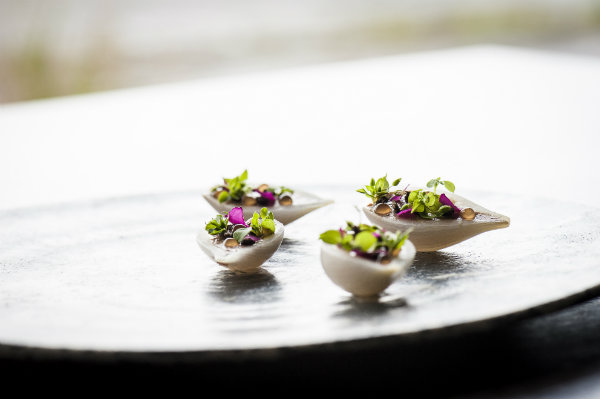
“There is a common language being spoken between a growing number of restaurants that think about sustainability, especially with the ever elusive goal of zero-waste,” says Orlando, who developed a recipe for coffee crisps made from oat flour, butter, sugar and used coffee grinds. “It is exciting to sit down with your friends and discuss how each one of us approaches it in a different way.”

For What It’s Worth
In 2016 Michelin awarded what it calls a Bib Gourmand to 10 Copenhagen restaurants that offer excellent value for the money. They aren’t the cheapest restaurants in the city, but if you want to treat yourself to a great dining experience, it’s safe to say you’ll be in good hands at any one of these places. The recognition also gives emerging chefs an opportunity to change perceptions of fine dining by making it more accessible.
“Even a lot of the cheaper restaurants are starting to use better ingredients,” observes 39-year-old Anita Klemensen, Denmark’s first female chef to snag a Michelin star for her work at The Red Cottage in Klampenborg, a few miles up the coast from Copenhagen.
At The Red Cottage, which received a Michelin star this year, a three-course meal sets you back about $80. Its sister bistro, The Yellow Cottage, offers three courses for about $50. At Relæ, the “anti-restaurant,” where every day the menu is a surprise, a four-course meal costs about $70.
This particular restaurant’s 34-year-old former Noma and El Bulli chef, Christian Puglisi, set out to create his answer to the excesses of fine dining in the form of an intentionally unfussy eatery furnished with repurposed tables and chairs. It wasn’t long before it was ranked 45th on Pellegrino’s list of the World’s 50 Best Restaurants and received the Sustainable Restaurant Award in 2015. Relæ has since upgraded the furnishings.
Back to the Garden
Another Noma graduate to strike out on his own is 37-year-old Danish Michelin-starred chef Torsten Vildgaard of STUD!O at the Standard, a 2013 development by gastropreneur Claus Meyer that houses three restaurants and a jazz club in a waterfront Art Deco building that was formerly a ferry terminal. Vildgaard recalls drawing pictures of his dream restaurant with multiple kitchens – including one for candy – as a child. He also describes having a moment of clarity when he tasted his mother’s curried egg salad at a young age.
“Looking back,” he says, “it was home cooking that inspired me to become a chef.”
He says it was that early exposure that fueled his Claus Meyer-inspired addiction in his teens to sourcing the best ingredients, even if people thought he was crazy to travel farther or pay more to find them.
“Imagine tasting curry when you’re four years old,” he says. “It was almost exotic for me. Now, it’s a thing you take for granted. But, you know, I just made it for my little girl and you could see, when she tasted it, there was something that made her aware of what she was eating.”
You’d think access to affordable organic food wouldn’t be an issue in what has statistically been ranked as the happiest country on Earth. While organic, ethically sound food options are available in supermarkets, Klemensen explains that it’s not always within reach for the average consumer.
“It’s just so much cheaper to buy a foreign tomato from the supermarket than a good, Danish tomato in the summertime,” she says. “And that’s a shame. If they could just taste it once, they’d never go back.”
The manifesto’s aim “to reflect the changes of the seasons in the meals we make” informs how Klemensen sources her kitchen’s ingredients. Because of the colder climate in the Nordic region, she says she is willing to reach beyond the border for essential ingredients that won’t grow in season in Denmark like pepper, chocolate or vanilla, as long as they are in season in their country of origin.
“Ten years ago,” she explains, “we looked to France and Italy to see what kind of things were in season and that’s what we would use. It’s very important for us to remember that Nordic Cuisine has been in a state of development. Now we are trying to use everything from our own backyard. And I think that’s the biggest step forward in the Nordic Kitchen.”
While she places the utmost importance on quality ingredients Klemensen says it’s just as important to make a good dish and to make people happy.
Spill the Wine
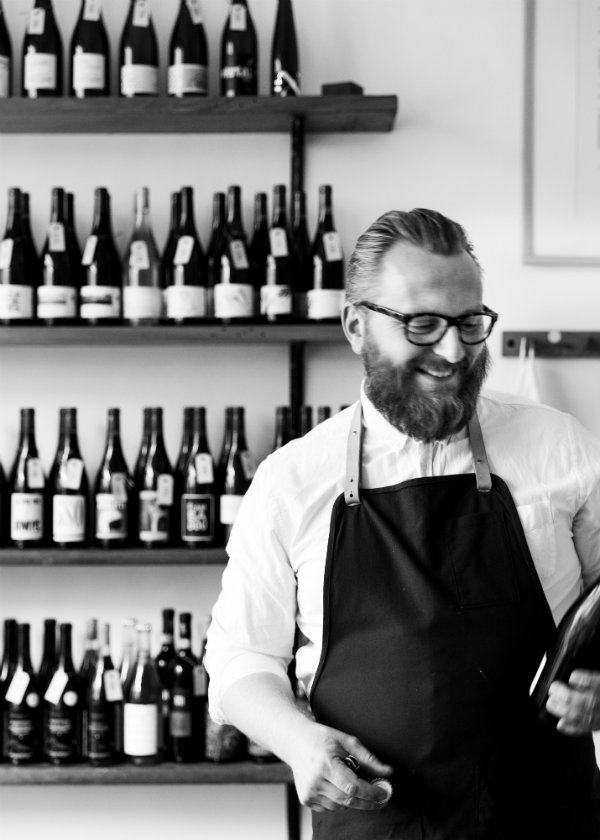
Danish chef, Solfinn Danielsen, who calls himself the “Flying Sommelier” for all the wine list take-overs he’s done in different countries, is co-owner of a bottle shop and pop-up restaurant venture called Rødder & Vin, or Roots & Wine, in the food-loving Nørrebro neighborhood of Copenhagen with his collaborating partner, Esben Grundtvig. Their focus is on bringing natural wines to the Nordic table and, of course, serving good food that makes people happy.
“It’s important for various reasons,” Danielsen explains. “But the primary reason is the honesty and diversity of taste. For me, the important thing is that the wine is artisan made. This just means that the same people who grow the wine, sell the wine. It’s not a mass produced product.”
Rødder is on a first name basis with its local growers and has been popping up at various food events for the past six years. The bottle shop just popped the cork to celebrate its second year in March. Except for wine that comes from France, Italy and Spain, everything is locally sourced, says Danielsen, a former bike messenger, who delivers all of the wine that he imports to the city’s restaurants on his custom-built Omnium.
“But we’re not fanatics,” he adds. “We still use lemons that come from Sicily, and things like that, but we try to lead by example.”
Food That’s Alive
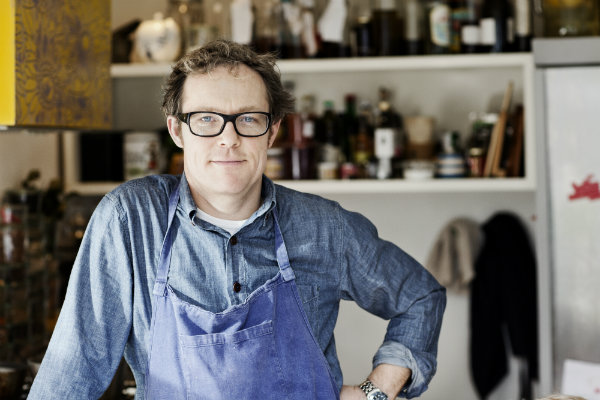
An important aim of the manifesto is “to combine the best in Nordic cookery and culinary traditions with impulses from abroad.” This has led to rediscovering ingredients that probably haven’t been eaten since before the industrial revolution as well as taking up ancient practices that never get old, like fermenting.
Danish chef, organic farmer, cookbook author, television personality, and all-around positive human being Søren Ejlersen released a new cookbook on the subject last year through People’sPress with Danish food stylist Ditte Ingemann and American fermenting expert Shane Peterson titled Fermentering.
“It’s a little weird that our tiny gastronomic country, Denmark, hasn’t taken it into average cooking yet,” Ejlersen says. “But we’re seeing it booming right now.”
Ejlersen explains that the top restaurants in the Nordic region have been fermenting for years. But his travels around Germany, England and especially the west coast in the United States reveal that the preservation method, that also has a long-standing tradition in the Nordic kitchen, is experiencing a revival in the home. Ejlersen describes the practice as the opposite of typical industrialized food preservation, calling it “food that’s alive.”
“Plants are magic,” he says. “Fermented food is actually alive. It farms your gut.”
He goes on to clarify that the probiotics found in fermented foods serve to cultivate a diversity of healthy bacteria in the intestines – about 1.5 trillion bacteria on a good day. White bread, pasta and sugary soft drinks can decrease the good bacteria your gut needs keep your immune system and energy levels strong, he explains. The good news is, fermenting at home is easy and anyone can do it.
“Fermented foods and beverages are my new dimension in the kitchen,” Ejlersen says. “I’m pretty addicted to the kombucha. I’ve even started a kombucha factory this year.”
On the self-sustaining farm in Barrit, Denmark called Aarstiderne, meaning “seasons,” Ejlersen grows and delivers produce and, most recently, his new line of kombucha to homes in Denmark. He is optimistic about outcompeting the soft drink market. When it comes to flavoring the fermented tea that contains trace amounts of alcohol, he says there is a universe of possibilities with real health benefits.
It’s a wild world in the New Nordic Cuisine scene where daily life is filled with competing priorities and compelling possibilities (see: pizza burger). As Denmark continues to develop a greater food awareness, the average diner in Copenhagen doesn’t have to look far to find a restaurant whose aim is to uphold the ideals of the New Nordic Kitchen.
Julie Vitto has contributed writing and photography to entertainment and lifestyle magazines covering central Pennsylvania, the Nordic region and points in between. She likes the theme song to Cheers.
Photo of Matt Orlando and Amass graffiti wall courtesy of Tim Spreadbury. Amass food photos courtesy of Amass. Photo of Søren Ejlersen courtesy of Aarstiderne.com. Photo of Solfinn Danielsen by Chris Tonnesen.